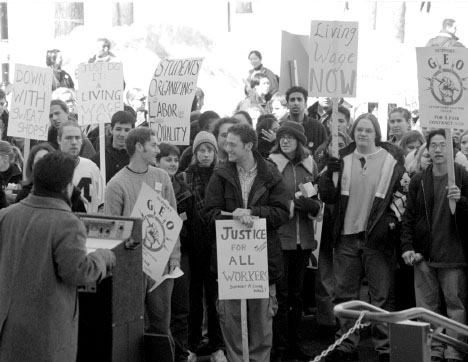The University Record, March 15, 1999
By Jane R. Elgass

After months of participation in an intercollegiate task force charged to create an anti-sweatshop code, the University is close to finalizing a far-reaching policy that attempts to ensure fair and humane working conditions.
In its efforts to create the policy, University officials have been working with the Student Organization for Labor Equity to address the group’s concerns about the use of sweatshop labor to produce apparel bearing U-M logos.
Marvin Krislov, vice president and general counsel, who along with Keith Molin of the Athletic Department has been meeting with the students, said last week that the U-M’s proposed code of conduct for apparel manufacturers “will be among the most comprehensive of any adopted by any college campus.”
The two groups have had three lengthy meetings in recent weeks, with full public disclosure of factory locations and compensation issues, the sticking points. Provisions of the code include a commitment to implementation, appointment of an anti-sweatshop advisory committee, compensation/living wage standards, protection of women’s rights and a call for public disclosure of the location of factories, described by Krislov “as one of the most important and far-reaching elements of the code.”
Krislov also noted that the University is prepared to support studies to look into the living wage issue. “Our living wage standards,” he noted, “will be comparable to those adopted by all the universities that so far have addressed this issue. We will be among the first four or five universities to have such a comprehensive code.”
Krislov and Molin, who is a member of the national task force working on a code to help guarantee safe, healthy and fair conditions for workers who produced licensed goods, credit the students with raising the level of awareness on the issue.
“We are impressed with their level of interest and commitment and look forward to working with them to implement a code,” Krislov said.
The U-M code complements recommendations of the task force to the Collegiate Licensing Co., most notably in the areas of living wages and full disclosure of factory locations. CLC is the licensing agent for the logos of more than 160 colleges, including the U-M.
The Nov. 13, 1998, Chronicle of Higher Education reported that universities have a $2.5 billion slice of the sports licensing pie, estimated to be as much as $15 billion.
According to Molin, retired senior associate athletic director, “among the schools that publicly report royalty sales, the U-M is the number one seller of licensed goods in the country,” amounting to $5.7 million in royalty revenue in 1997-98, the year that the U-M won national championships in football and hockey.

